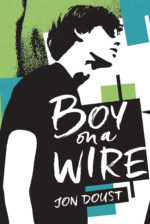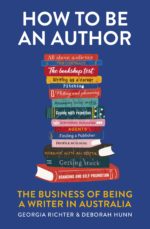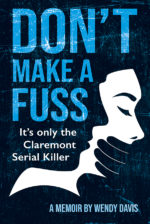Despite the prevalence of malevolent-looking koala windcheaters, Fremantle Press publisher Georgia Richter says life doesn’t always deliver ready-made plots and diaries should be an end in themselves

He’s over there!

I recently finished reading How to End a Story, Helen Garner’s third volume of her edited diaries. I read it as my daughter was studying Monkey Grip for her VCE. In a captivating February session at the Perth Festival Writers Weekend, Garner told interviewer Gillian O’Shaughnessy that some reviewers complained that Monkey Grip – with its portrait of 1970s communal counterculture in Melbourne – read as if it had been lifted from a diary. Garner said to the audience: ‘What was the problem? It had.’
Monkey Grip proceeds with a kind of blind inevitability, and the casual unfolding one might ascribe to a journal. But on the first page, Nora offers this observation: ‘And everything, as it always does, began to heave and change.’ Therein lies the clue: any amount of transposing from life may lie in a novel’s origins – but only a skilled writer can make fiction read as if it were real.
In diaries, dramatic irony is more the province of the future reader than of its author. In How to End a Story, the reader witnesses the unravelling of a marriage between two writers that takes place on his turf, where the question of who gets to have a room of their own to write in is always resolved in favour of the husband. In real time, the diarist is not aware what story she is participating in. For the longest while, and no matter in what detail she records it, Garner fails to see her husband’s role in the disintegration of their marriage, though the reader (said O’Shaughnessy) is like the audience in a pantomime, pointing and shouting, ‘Look behind you! He’s over there!’
For the reader, the aftermath of the aftermath is this glorious prose – where life presents a plot, and the writer’s skilful selection shines a light on the inevitability of a doomed relationship – made magnificent by the muscular brilliance of Garner’s writing, and her canny editing.
When I was eighteen, I discovered Garner’s novels and stories in unchronological order. I started with The Children’s Bach (1984), then went backwards to Monkey Grip (1977), then on to her short story collections and new novels. As her narrative non-fiction career took off, I gladly followed her there. Whatever the genre, I was electrified by the lightning honesty that runs through her prose, and the way Garner notices place and people. I consciously began to observe and record the world around me in the way she did. In the early 1990s, I also began to extract from my own diaries to see if the sum of my observations would add up to a Garner-esque whole.
It may have been the Monkey Grip model, but I was missing several key points in thinking my diaries were a novel waiting to happen:
- Life does not always deliver plotlines. At twenty, I was a long way from having a decent plot of my own.
- One cannot always lean on the work itself to produce meaning – often, diaries are novels minus the craft and the alchemy.
- Diaries can (and mostly should) be an end in themselves.
The gauntlet is thrown
When I was twelve, we watched a video at school of some guy sitting in front of rows of his own diaries, which he had been keeping for a very long time. I looked at them, and at him, and thought: Right, you’re on.
I didn’t start keeping a diary properly until I was fourteen: on January 1, 1984 I began diary #1 purchased with a Christmas gift voucher from Angus & Robertson. Now I am up to diary #177. I write almost every day. The diary is the place to be as free as I need to be. To offload into it as if it was Dumbledore’s Pensieve. And, I think, to practise the practice of language, which is at the foundation of my career as a publisher and editor.
What do these 177 red-and-black books amount to? In essence, I write in them because they create the momentary illusion that I am guiding my narrative; it is the assertion of a control nobody actually has, on either the darkest days or the brightest ones.

Inheritance
When I moved to Perth in 1993 to do an MA in creative writing, my dad sent me his translated diary entries from 1951, when he and his mother and brother emigrated from Germany. The Second World War had destroyed much of everything in his world: it claimed the life of his father in combat, and of his grandfather, murdered by Russians at home. My dad himself had escaped Russian internment as his captured platoon was marched east. Klaus, aged sixteen, buried himself deep in the hay in a barn where the captive soldiers slept overnight. He was so far in that the Ivans did not find him with their pitchforks, which they thrust into the hay in the morning.
Upon arrival in Australia, my father’s diaries are full of comparisons as he writes himself into the landscape:
Friday April 6, 1951
‘It is just like it was in Colombo: we wake up and find we are in port. About 7 am the Cyrenia is pulled by the tug-boats into the Port of Fremantle. The first Australian port, in fact the first Australian land we have ever seen. Sunrise – and a gold sun emerges from a dark cloud bank over the land. We can see the coastline, long, flat, and yellow dunes, some bushes and some trees. Actually it looks very much like the Baltic Coast in Germany. Beyond the port one catches glimpses of a town. It reminds me of Wesermünde: large, wooden warehouses, advertising hoardings etc. One feels very much at home: no dirt, no traders in small boats, surrounding the ship.’
The young man, dispossessed, sees the new world in terms of what he has known. Unlike the ports they encountered along the way, things are ‘cleaner’ here; he looks for, and finds, things to remind him of home.
When the Richter family made landfall on the west coast, before heading on to Victoria, my dad could not have dreamed that one day his daughter would raise his grandchildren in Fremantle, or that he would ensure their 1951 arrival was recorded, like hundreds of others, on the Welcome Walls of a maritime museum that did not yet exist.

In 1951, Klaus’s future wife was winning ribbons at New Zealand’s Wairoa Show for the Highland fling, Irish jig and sailor’s hornpipe in the under-twelve division. She was still a decade away from a life-changing meeting with my father during a week’s holiday in Fiji.
I have some parts of my mother’s diary from when she was sixteen (as excised by her). In June 1957, she wrote:
‘I am now much older and wiser in the head … I had a long talk with [my teacher] Jasper today and I find out just where I stand. As far as he’s concerned, I have more between my two ears than any kid in our class … He said that with cleverness or intelligence or brain power also went a sort of pigheadedness, unfortunately … We got around to talking about OT. I applied a couple of days ago and the form came today. Jazz said he had had two years of OT in an army hospital and he said that the finest women he has ever met were OT. This profession requires a mature outlook. I wonder if I have got it. It makes you think.’
Over the next twelve months or so, Kay becomes dux of her school, and her entries go on to record how much she loves occupational therapy training and how it is changing her. The girl in these pages has my mother’s voice – familiar and unfamiliar at the same time.

Out of curiosity, I set myself a task. In my own diaries, I go to the same month at the same age my parents were in each of the above entries to see how our selves align.
My mother and I at sixteen
My mother and I were born on the same date, thirty years apart. In June 1987, aged sixteen, I am in the middle of Year 11 exams and interacting with my teachers in the same way my mother did with Jazz:
‘I had a half hour talk with Mrs Joyce in Greek & Roman, which was done at three metres – she at her desk and me draped along the heater in Room 14. It began with The Odyssey and The Iliad, went through the brilliance of the Greek mind, the negative approach of today’s Mind (encompassing the Daily News), how Optimism should be our key to the future, the Fit for Life Diet Mrs Joyce is on, and Star Signs. Librans, she told me, take a long, long time to come to a decision, weighing up the ins and outs of both sides.’
Although (despite Mrs Joyce’s encouragement) I dropped history at uni, I did go on to try the Fit for Life diet myself, with unpleasant results.
In that June 1987 period, I complete my maths exam: ‘It was an extremely difficult exam and Mrs Swale was wearing her malevolent koala windcheater, which made it not easy’ – a reference to the glued-on sheepskin koalas with their plastic claws that rose and sank on the platform of my teacher’s bosom. In a flash, my diary makes those koalas vivid again.
My father and I at twenty-one
On 6 April 1991, my father was sixty-one, and I was twenty-one. We were heading home from a trip visiting my mother’s New Zealand family. In that entry, I observe that Dad is packing, which is something he likes to do, and ordinarily I like it too. But I am not in the mood for it right then:
‘Dad said to me this evening that he didn’t mind me laughing and being silly when I was sixteen (‘I seem to recall that you did,’ I told him) but now I was an adult it was different. He said I was welcome to behave that way when he was not around but when he was, I was not to spoil his enjoyment.
‘That rankles – he can equally annoy me, yet I may say nothing. He must be one of the few people who would presume to tell me what to do, and that sort of curbing is perhaps indirectly aimed at Mum – because he won’t tell her to stop laughing, to stop being silly in collusion with me, so he tells me instead.’
This entry moves from my annoyance with my father into drafting into my diary some more of a short story. It was one way to give a voice to my frustration in a family where any friction was subterranean. Where things were, literally, non-negotiable.
As a result of the war, my father was done with conflict, and he would brook none. His children were raised in an environment of passive control, which was imposed on us in ways like the one above.
Reading this exchange, I can still feel what it is like to be told to stop ‘being silly’, to stop being myself. I also glimpse my mother in the background, quick to laughter – who my father would not directly criticise, because he refused to be at odds with her, even when they were.
Things change. Twenty-five years later, Klaus became softer, more appreciative. (‘Isn’t it lovely to see their lovely, shining faces?’ he once said to me when all his grandchildren were gathered at the table, laughing and talking just as they pleased.) But the April 1991 entry reminds me why I am still conflict averse, and why I feel mutinous resistance when a man tells me what to do.
Books that come from life
If diaries unfold forwards, a memoir works backwards – a life reconstructed retrospectively, meaning imposed.
In the aftermath of the arrest of Robert Bradley Edwards, Wendy Davis began compiling the memories of a brazen 1990 attack on her in her workplace. In the beginning, she wasn’t consciously reconstructing anything. She began after the police made contact with her following Edwards’ arrest. Writing down the long-suppressed memories that rose to the surface was the one thing she could do to take charge of her story. Then, as #MeToo happened, she also saw that her experience – what happens because women go unheard and are enculturated not to speak out, with sometimes tragic consequences – was shared by many women around her. Those notes of painful, necessary remembering became a memoir called Don’t Make a Fuss: It’s only the Claremont Serial Killer.
As well as memoir, there is autofiction – autobiographical fiction drawn from the writer’s life. Jon Doust’s Boy on a Wire is autofiction (a ‘dislocated memoir’ we described it, on the back blurb). So is Simone Lazaroo’s Illuminations of a Nocturnal Mother, a novel I am currently editing, which for all the world feels like a window into the courtship and life of Simone’s parents. But it isn’t an exact rendering – it only appears to be.
Monkey Grip is autofiction too.

A diary, however, is just itself. Life events determine the contents, though they may be edited to reveal engaging through-lines. Of course, it’s better for a future reader if the diarist is a writer. Garner’s diaries are clearly places where she has honed her craft. Elsewhere (with a gorgeous use of semi-colons), Garner asks:
‘Why the sneer in “All she’s done is publish her diaries”? It’s as if this were cheating. As if it were lazy. As if there were no work involved in keeping a diary in the first place: no thinking, no discipline, no creative energy, no focusing or directing of creative energy; no intelligent or artful ordering of material; no choosing of material, for God’s sake; no shaping of narrative; no ear for the music of human speech; no portrayal of the physical world; no free movement back and forth in time; no leaping between inner and outer; no examination of motive; no imaginative use of language.’
‘Writing,’ Garner observed in Perth, ‘is the thing that makes it possible to live it.’ In How to End a Story, Garner has bent her life’s material to the pages as if she were a character in a story. That is the quality that makes her diaries masterpieces too.
Not every diary sees the light of day. Under my son’s bed are the diaries and personal papers of my family. Some are in German and I cannot read them. They are evidence of the way days spool away, and how large life feels as one records it.
My son is twenty-one and has moved from Fremantle to the east coast. He is no diary-keeper, but one of my daughters keeps a journal. I often glimpse her at day’s end, writing on her bed, doing what I do too – recording the fleeting moments of now.
Georgia Richter is a publisher, editor, teacher and co-author of How to Be An Author: The Business of Being a Writer.
References
Helen Garner, interviewed by Gillian O’Shaughnessy, Perth Festival of Literature and Ideas, Fremantle Arts Centre, Sunday 27 February 2022.
Helen Garner, “I”, https://meanjin.com.au/essays/i/





